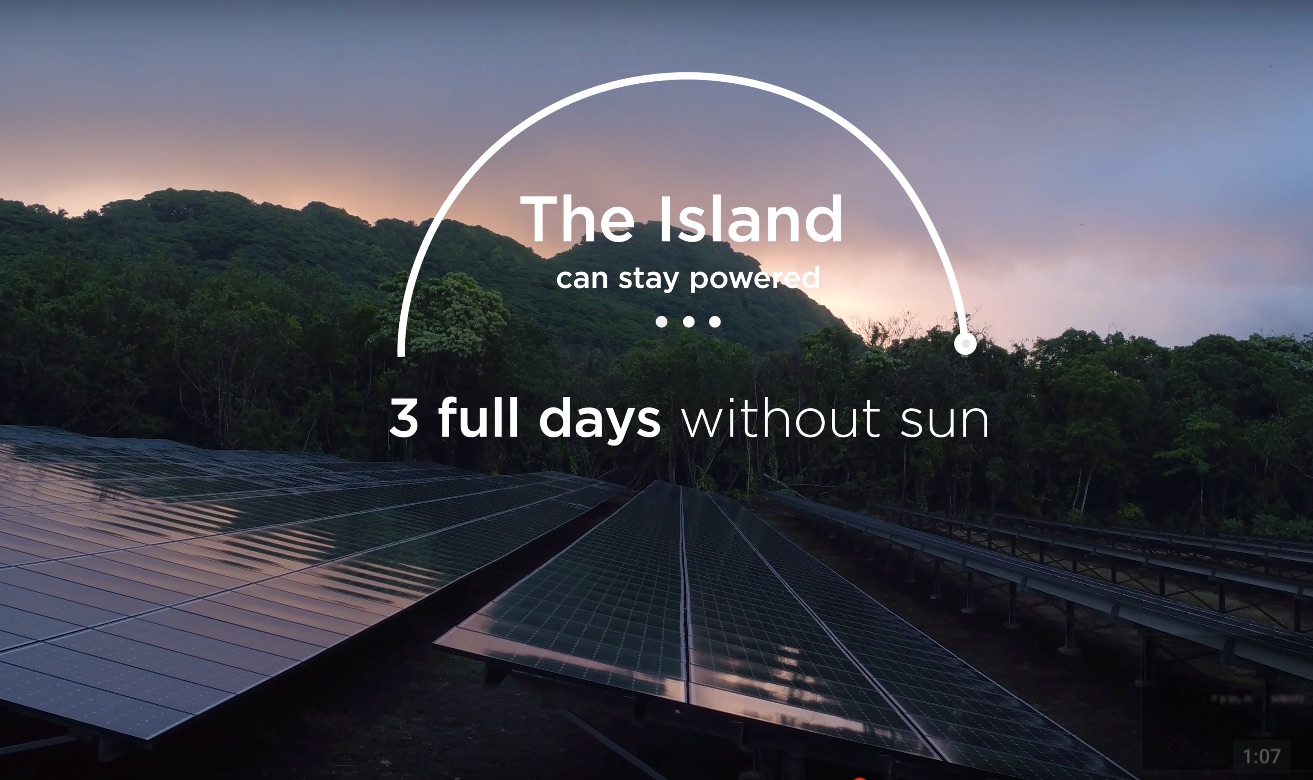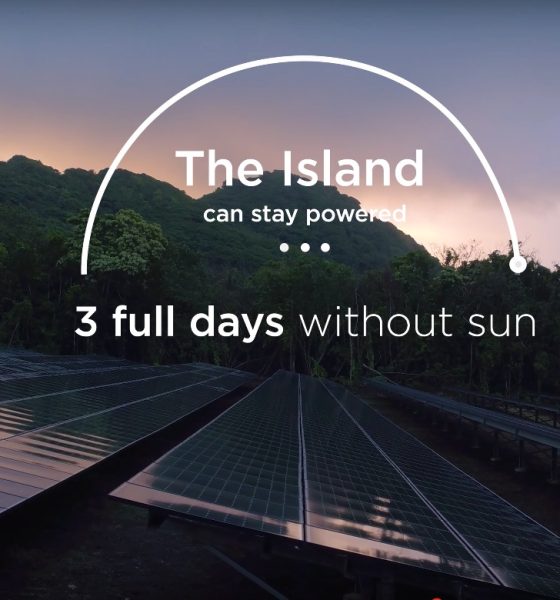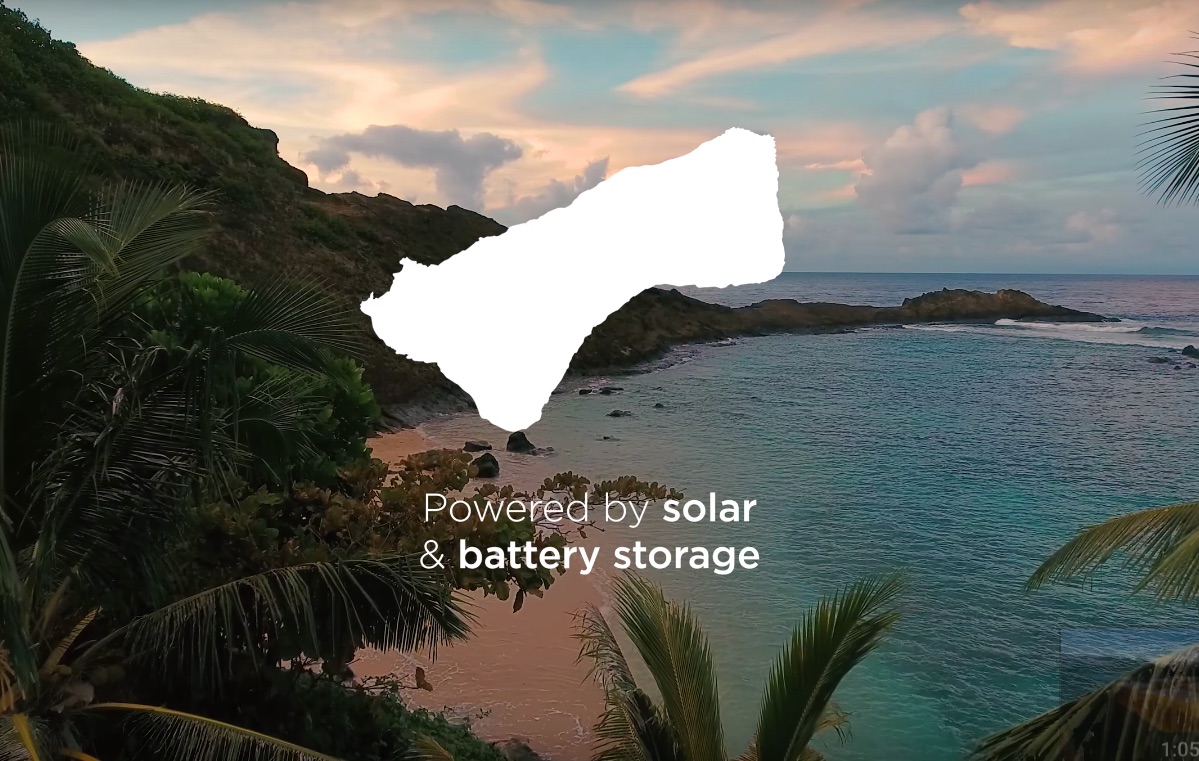

Energy
Why Tesla’s microgrid project is life changing for Ta’u’s island community
Tesla’s subsidiary, SolarCity, is at the end of a one-year solar energy microgrid project on the American Samoa island of Ta’u that, at 1.4 megawatts, can cover “nearly 100%” of its 600 residents’ electrical needs. Its benefits may be life changing for residents of Ta’u.
Ta’u is a rectangular island 10 km. long and 5 km. wide. In the distant geologic past, the south side of Ta’u collapsed, leaving dramatic 500 km. high cliffs that rise directly from the southern sea. Craters punctuate the island’s wild, thickly forested interior, known for its steep slopes and gullies. Terrain and bush can change quickly, and most of the upland area is inaccessible. American Samoa was first visited by European explorers in the 18th century, but its islands have been inhabited for over 3000 years. Today, at about 340 persons per square km., American Samoa is the second most densely populated South Pacific entity, after Tuvalu.
The island’s residents have acquired power to date largely through generators fueled by diesel. Diesel in itself is made from chemicals including sulfates, ammonium, nitrates, elemental carbon, condensed organic compounds, and even carcinogenic compounds rich in heavy metals such as arsenic, selenium, cadmium and zinc. Diesel exhaust poses major health hazards, contributes to climate change, is costly to ship, and can lead to frequent temporary blackouts. With a dramatic decrease on diesel reliance, Ta’u, through the SolarCity renewable microgrid, will experience valuable community life enhancements that can increase local control and community independence.
Grid stability in a remote location
Energy efficiency is an important component of a renewable microgrid transition. Energy storage is key to renewable island and remote community microgrids. The Ta’u integrated microgrid –- 1.4 megawatts of solar power and 6 megawatt hours of battery storage from 60 Tesla Powerpack, alongside smart controls to enable load shifting— will become an important component of the Ta’u community’s transition to energy independence.
Maintaining grid stability with renewable integration has proved challenging in many other remote island cases in which energy reliance has shifted to a microgrid. SolarCity will likely use a phased integration approach that will initially bring a small amount of renewable technologies online, as it works to balance the system, and then continue to step up their renewable penetration by integrating more solar resources alongside energy storage and advanced controls. For example, on King Island, Australia, Hydro Tasmania has overcome many renewable integration challenges to incorporate more renewable resources into the system. Simon Gamble recalls, “We started adding renewables 18 or 19 years ago, and the challenges have been technical. We had to solve the problems we uncovered as we went.”
Tesla’s Powerpack system will allow the island to use stored solar energy at night, meaning renewable energy is available for use around the clock. Procuring and transporting new technologies and equipment, which has been an issue with other remote island locations that have integrated a renewable energy microgrid, may not present as many challenges for Ta’u, due to the SolarCity involvement. Often, only one or two operators live nearby, so if major technical issues arise, teams must fly in to address the problems. Having SolarCity as a partner can diminish such technical issues on Ta’u.
How a SolarCity microgrid can alter traditional microgrid instability
Although some renewable systems have found success, other communities face challenges transitioning from a fossil fuel reliance to a microgrid. A SolarCity microgrid has the capacity to overcome these challenges due to the influence and reliability of Tesla Energy. Microgrid systems foster community resiliency and stability. Power electronics and control systems enable a more stable grid through better controls. At the same time, relying more on local resources and less on imported diesel increases overall resiliency for the Ta’u community.
Transitioning to renewable microgrids can reduce costs. Research indicates that relying on more diversely and renewably powered microgrids has led to reduced diesel usage, electricity prices, and operating costs. Creating a project like the SolarCity microgrid on Ta’u, with the requisite business plan to lower overall costs and attract investment, is a difficult and lengthy task. However, it has clearly been made easier with SolarCity’s deep understanding of inherent necessary technologies, processes, and pitfalls.
Protecting the Ta’u culture through energy independence
Fa’a Samoa or the Samoan Way is the foundation of Samoan society, culture, and heritage. Fa’a Samoa customs and culture are over 3000 years old and have changed very little over this period. The Fa’a is tenaciously defended by those who have chosen to remain in their home villages rather than to emigrate to the U.S. Fa’a culture and customs are based around the mutual respect given to elders, the church, visitors, and the extended family. The SolarCity grid will enhance the Fa’s or Samoan Way and reinforce the foundation of Samoan society, culture, and heritage.
SolarCity, alongside American Samoan and U.S. authorities, including the Department of Interior, has provided the upfront costs of designing, delivering, installing, and maintaining the solar microgrid. Their customers on Ta’u will pay a fixed monthly fee for clean solar power and start realizing cost savings from day one without the hassle of owning and maintaining their own power system. Removing the hazards of power intermittency will offer a tremendous difference in the lives of Ta’u residents.
“I recall a time they weren’t able to get the boat out here for two months,” said Keith Ahsoon, a local resident whose family owns one of the food stores on the island. “We rely on that boat for everything, including importing diesel for the generators for all of our electricity. Once diesel gets low, we try to save it by using it only for mornings and afternoons. Water systems here also use pumps, everyone in the village uses and depends on that. It’s hard to live not knowing what’s going to happen. I remember growing up using candlelight. And now, in 2016, we were still experiencing the same problems.”
Sources: American Samoa, Renewable Microgrids
As Tesla owners, solar advocates and obvious believers in the future of sustainable energy, we’ve partnered with a service for estimating solar costs based on one’s location and energy requirement. Please consider supporting our solar-focused affiliate partner and fan to Teslarati by getting a cost estimate.

Cybertruck
Tesla updates Cybertruck owners about key Powershare feature

Tesla is updating Cybertruck owners on its timeline of a massive feature that has yet to ship: Powershare with Powerwall.
Powershare is a bidirectional charging feature exclusive to Cybertruck, which allows the vehicle’s battery to act as a portable power source for homes, appliances, tools, other EVs, and more. It was announced in late 2023 as part of Tesla’s push into vehicle-to-everything energy sharing, and acting as a giant portable charger is the main advantage, as it can provide backup power during outages.
Cybertruck’s Powershare system supports both vehicle-to-load (V2L) and vehicle-to-home (V2H), making it flexible and well-rounded for a variety of applications.
However, even though the feature was promised with Cybertruck, it has yet to be shipped to vehicles. Tesla communicated with owners through email recently regarding Powershare with Powerwall, which essentially has the pickup act as an extended battery.
Powerwall discharge would be prioritized before tapping into the truck’s larger pack.
However, Tesla is still working on getting the feature out to owners, an email said:
“We’re writing to let you know that the Powershare with Powerwall feature is still in development and is now scheduled for release in mid-2026.
This new release date gives us additional time to design and test this feature, ensuring its ability to communicate and optimize energy sharing between your vehicle and many configurations and generations of Powerwall. We are also using this time to develop additional Powershare features that will help us continue to accelerate the world’s transition to sustainable energy.”
Owners have expressed some real disappointment in Tesla’s continuous delays in releasing the feature, as it was expected to be released by late 2024, but now has been pushed back several times to mid-2026, according to the email.
Foundation Series Cybertruck buyers paid extra, expecting the feature to be rolled out with their vehicle upon pickup.
Cybertruck’s Lead Engineer, Wes Morrill, even commented on the holdup:
As a Cybertruck owner who also has Powerwall, I empathize with the disappointed comments.
To their credit, the team has delivered powershare functionality to Cybertruck customers who otherwise have no backup with development of the powershare gateway. As well as those with solar…
— Wes (@wmorrill3) December 12, 2025
He said that “it turned out to be much harder than anticipated to make powershare work seamlessly with existing Powerwalls through existing wall connectors. Two grid-forming devices need to negotiate who will form and who will follow, depending on the state of charge of each, and they need to do this without a network and through multiple generations of hardware, and test and validate this process through rigorous certifications to ensure grid safety.”
It’s nice to see the transparency, but it is justified for some Cybertruck owners to feel like they’ve been bait-and-switched.
Energy
Tesla starts hiring efforts for Texas Megafactory
Tesla’s Brookshire site is expected to produce 10,000 Megapacks annually, equal to 40 gigawatt hours of energy storage.

Tesla has officially begun hiring for its new $200 million Megafactory in Brookshire, Texas, a manufacturing hub expected to employ 1,500 people by 2028. The facility, which will build Tesla’s grid-scale Megapack batteries, is part of the company’s growing energy storage footprint.
Tesla’s hiring efforts for the Texas Megafactory are hinted at by the job openings currently active on the company’s Careers website.
Tesla’s Texas Megafactory
Tesla’s Brookshire site is expected to produce 10,000 Megapacks annually, equal to 40 gigawatt hours of energy storage, similar to the Lathrop Megafactory in California. Tesla’s Careers website currently lists over 30 job openings for the site, from engineers, welders, and project managers. Each of the openings is listed for Brookshire, Texas.
The company has leased two buildings in Empire West Business Park, with over $194 million in combined property and equipment investment. Tesla’s agreement with Waller County includes a 60% property tax abatement, contingent on meeting employment benchmarks: 375 jobs by 2026, 750 by 2027, and 1,500 by 2028, as noted in a report from the Houston Business Journal. Tesla is required to employ at least 1,500 workers in the facility through the rest of the 10-year abatement period.
Tesla’s clean energy boom
City officials have stated that Tesla’s arrival marks a turning point for the Texas city, as it highlights a shift from logistics to advanced clean energy manufacturing. Ramiro Bautista from Brookshire’s economic development office, highlighted this in a comment to the Journal.
“(Tesla) has great-paying jobs. Not just that, but the advanced manufacturing (and) clean energy is coming to the area,” he said. “So it’s not just your normal logistics manufacturing. This is advanced manufacturing coming to this area, and this brings a different type of job and investment into the local economy.”
Energy
Tesla and Samsung SDI in talks over new US battery storage deal: report
The update was related by industry sources and initially reported by South Korean news outlets.

Recent reports have suggested that Tesla and Samsung SDI are in talks over a potential partnership to supply batteries for large-scale energy storage systems (ESS).
The update was related by industry sources and initially reported by South Korean news outlets.
ESS batteries to be built at Samsung’s Indiana plant
As noted in a report from Korea JoongAng Daily, the demand for energy storage systems has been growing rapidly in North America, thanks in no small part to the surge in AI investments across numerous companies. With this in mind, Tesla has reportedly approached Samsung SDI about a potential battery supply deal.
The deal is reportedly worth over 3 trillion Korean won (approximately $2.11 billion) and will span three years, according to The Korea Global Economic Daily. A battery supply deal with Samsung SDI could make sense for Tesla as the company already has a grid-scale battery, the Megapack, which is perfect for industrial use. Samsung SDI could simply supply cells for the EV maker.
Production of the batteries would reportedly take place at Samsung SDI’s joint venture factory with Stellantis in Indiana, which is currently under construction. Samsung SDI recently announced plans to use part of that plant’s EV lines to produce cells for ESS, with a targeted capacity of 30 GWh by the end of next year.
Tesla and Samsung’s partnership
At present, only a handful of manufacturers, including Korea’s LG Energy Solution, Samsung SDI, SK On, and Japan’s Panasonic, are capable of producing energy storage-scale batteries domestically in the United States. A Samsung SDI official issued a comment about the matter, stating, “Nothing has been finalized regarding cooperation with Tesla.”
The possible energy storage system deal adds another layer to Tesla’s growing collaboration with Samsung, which is already in line as a partner in the upcoming production of Tesla’s AI5 and AI6 chips. Early sample manufacturing of the AI6 is expected to begin in South Korea, with mass production slated for Samsung’s Texas-based Taylor foundry when it starts operations.
The AI6 chip will power Tesla’s next wave of high-volume projects, including the Optimus humanoid robot and the autonomous Cybercab service. Musk has called the partnership with Samsung a “real collaboration,” adding that he personally plans to “walk the line” at the Taylor facility to speed up progress.










